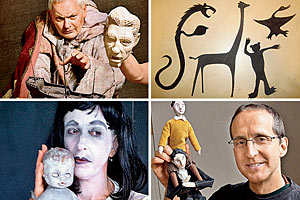

One of the oldest forms of puppetry, characterized by a puppeteer using long sticks to control a puppet’s movements, often working below a figure. You don’t have a box, you have permission to step outside.’ He’s very sensitive to the fact that when you don’t give away tradition, it dies.” “But when (he and Nishikawa) started working, he said ‘Tom, I am by virtue of tradition inside a box. Lee said Bunraku companies inside Japan are mostly male and rarely open to Western puppeteers. The show, which draws on Japanese storytelling traditions, is about a meeting between a samurai and astronomer.

17-19 at the Art Institute of Chicago, is a collaboration between himself and Koryu Nishikawa V, the fifth-generation master at Hachioji Kuruma Ningyo, the 160-year old theater outside Tokyo that has become the world’s leading practitioner of the form. “It’s like rolling around in an office chair, except it’s smaller, you’re on stage and have a puppet attached to you.” His show, “Shank’s Mare,” Jan. Tom Lee, a Chicago puppeteer who specializes in cart puppetry, explained: The puppeteer holds the puppet’s feet between his toes, operates the head and left arm with his left arm and the right arm with his right arm. It is performed rarely outside Japan (and not especially well-known anymore inside Japan). Kuruma Ningyo, though, is Bunraku adapted to a single puppeteer, working on a small rolling cart. (Ayumi Sakamoto)īunraku is traditional Japanese puppetry that uses three puppeteers to manipulate a life-size character. 17-19 at the Art Institute of Chicago, part of the Chicago International Puppet Theater Festival. Many of the puppets were made by Jim Henson’s Creature Shop in Queens (which makes the puppets for “Sesame Street”), though Heather Henson said: “My whole career I have been moving around what people wouldn’t necessarily call characters so much as ambiance - waves and grasslands and. The show, written by Defoe, and drawing from various First Nations influences, pulling together dance and a parade-like pageantry, tells the story of a sand hill crane traveling from Canada to the Gulf. Henson specializes in shows about cranes and the natural environment, and said the spectacle here is less about size - though there are enormous sea turtles and dragons and herds of buffalo roaming the stage - than “getting wooed by imagery itself.” Buffalo resemble clumps of grasslands, coyotes look like cobbled together corn and the deer look pieced together by branches. Fittingly, “Ajijaak on Turtle Island,” the festival’s opening show, Jan 17-20 at the Fine Arts Building, is a collaboration between Heather Henson, the late Jim Henson’s youngest daughter, and Ty Defoe, a performance artist from Ojibwe and Oneida communities of northern Wisconsin.

As the name implies, the flashiest puppetry genre, often using immense characters (Broadway’s “Kong Kong”), or requiring puppeteers subsumed inside a puppet (the “War Horse” stage production), or just recognized by a single name: Henson.


 0 kommentar(er)
0 kommentar(er)
